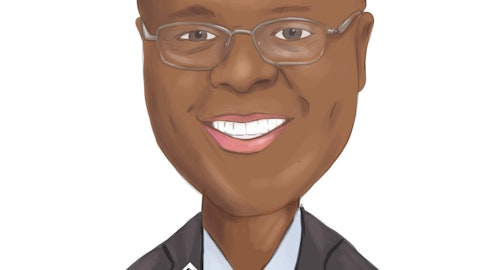Premier Financial Corp. (NASDAQ:PFC) Q3 2023 Earnings Call Transcript October 25, 2023
Operator: Good morning and welcome to the Premier Financial Corp. Third Quarter 2023 Earnings Conference Call. My name is Ellen and I will be the operator for today’s call. [Operator Instructions] Please note that this event is being recorded. I would now like to turn the call over to Paul Nungester with Premier Financial Corp. Paul, please go ahead, whenever you’re ready.
Paul Nungester: Thank you. Good morning, everyone and thank you for joining us for today’s third quarter 2023 earnings conference call. This call is also being webcast and the audio replay will be available at the Premier Financial Corp. website at premierfincorp.com. Following our prepared comments on the company’s strategy and performance, we will be available to take your questions. Before we begin, I’d like to remind you that during the conference call today, including during the question-and-answer period, you may hear forward-looking statements related to future financial results and business operations for Premier Financial Corp. Actual results may differ materially from current management forecasts and projections as a result of factors over which the company has no control.
Information on these risk factors and additional information on forward-looking statements are included in the news release and in the company’s reports on file with the Securities and Exchange Commission. I’ll now turn the call over to Gary for his opening comments.
Gary Small: Thank you, Paul and good morning. Thank you all for joining us. On behalf of the Premier team, I am pleased to announce third quarter earnings of $24.7 million or $0.69 per share. Results were in line with our expectations for the quarter and represents favorable performance versus consensus expectations. Core net income was up $0.5 million or 2% on a linked-quarter basis. We posted an ROA of 1.14%, and our return on average tangible equity came in at 15.6% for the quarter. EPS topped quarter two results with net interest income up 2% on an annualized basis and net interest margin improving slightly versus the prior quarter. Year-to-date loan growth stands at 4% and our average loan growth for the quarter was up 2.9% on an annualized basis, and that was a bit better than our – we had anticipated.
C&I originations were 40% of the third quarter commercial commitments. Commercial line utilization rate is at a 2-year low point. Our clients are using their excess cash to pay down their loan positions. Customer deposits closed at 5.6% for the quarter on an annualized basis with business deposit growth leading the way, climbing 11% annualized for the quarter. From a credit perspective, loan delinquency declined on a linked-quarter basis, and we finished the quarter in a net recovery position of $300,000 plus. Non-accrual category was up slightly due to a single commercial C&I credit, nothing systemic to report. We did see an increase in the special mention category, driven by two loans, one a C&I loan, the other multifamily. Each loan is performing and the required adjustments expected are to be – are expected to be achievable.
We have strong guarantors in each situation. Non-owner occupied office exposure was down 7.5% on a linked-quarter basis, coming in at just under $208 million. Premier benefits from relatively low concentration in this category and the portfolio has low re-lease and repricing risk. We had a strong Q3 fee income. We were up $334,000 or 2.6% on a linked-quarter basis when adjusting for insurance revenue. Wealth Management and deposit-related fee income was up 11.3% and 6.1%, respectively versus Q3 of the prior year. Residential mortgage fee income totaled $3.3 million, and that was up 14% on a linked-quarter basis. The gain on sale margin improved and hedges in place to support the construction commitments benefited from the rising rate environment.
Our cost reduction efforts continue to pay off. Our efficiency ratio improved to 56.5% for the quarter. Premier has always maintained a very low cost basis per earning asset ratio. And as a result, we are about 30% – 30 basis points, I should say, lower than our peers on that factor. And it’s really helping to offset our current margin challenges. Our low-cost structure will serve as a springboard for performance when combined with a more typical yield curve in the future. We’ve recently launched a new digital banking platform, improving our mobile and online banking capabilities, has great new features and services, provides a better omnichannel experience for our clients. The consumer platform is in place and a new small business banking digital platform is coming on board in early ‘24.
Each adds a great deal of ease and flexibility relative to future digital enhancements, additional middleware, etcetera. Our consumer clients have been clamoring for digital improvements and the new product has been well received. 88% of our active users converted in just the first week, the system really delivers. In combination with our recent enhancements to our treasury management integrated payment product set, we’re really well positioned to drive additional deposit growth going forward. Consumer clients as a whole are working deposits down, although balances are still above 2019 levels, and we see no issues at this time on the consumer credit front. Commercial clients are maintaining a conservative position, some slowing on expansion thoughts as rate and economic conditions vacillate.
We have little to no exposure to the challenges facing the Big 3 auto group or significant suppliers. There are plans within our markets that have been affected, but each market tends to be well diversified, industry-wise and we all look forward to an amicable contract resolution. We have good commercial opportunities throughout our markets and a number of regional and community banks are on the sidelines. We are expecting to capitalize on these opportunities selectively. And now I’ll turn it over to Paul for more details.

A portrait of a professional insurance broker at their desk, reviewing a policy. Editorial photo for a financial news article. 8k. –ar 16:9
Paul Nungester: Thank you, Gary. I’ll begin with the balance sheet where total deposits increased by 4.1% point-to-point annualized, primarily due to customer deposits that increased 5.6% annualized. We did continue to experience an impactful mix migration during the quarter, including decreases in savings, demand and non-interest-bearing deposits, which were more than offset by increases in time and public fund deposits as customers keep seeking higher yields. On the other side, total earning assets declined primarily as we allowed securities and other earning assets to roll off. Our loan-to-deposit ratio improved by 110 basis points and we were able to reduce higher cost wholesale fundings by $137 million due to the combination of strong customer deposit growth and modest earning asset contraction.
As a result of these balance sheet changes, plus having a full quarter benefit from the swaps we executed in June, net interest margin stabilized and actually eked out a 1 basis point increase for 3Q. Total interest-bearing deposit costs increased 47 basis points to 2.54% for 3Q, which was primarily due to the mix migration I mentioned earlier. Total average customer deposit costs in September, including non-interest, but excluding broker deposits and marks accretion were 1.85%. This represents a cumulative beta of 32%, up from 28% in June compared to the change in the monthly average effective federal funds rate, which increased 525 basis points from December 2021 to 5.33%. Net interest margin was positively impacted by the combination of previous loan growth and higher loan yields, which were 5.12%, up 26 basis points from the prior quarter.
Excluding the impact of PPP and marks, loan yields were 5.07% in September 2023 for an increase of 126 basis points since December 2021. This represents a cumulative beta of 24% compared to the change in the monthly average effective federal funds rate for the same period. Next, excluding insurance commissions and the insurance agency gain on sale last quarter, non-interest income increased 2.6% to $13.3 million in 3Q. This increase was primarily due to mortgage banking income where gains increased $342,000 from last quarter, primarily due to better margins. Excluding transaction costs for the insurance agency sale last quarter, expenses of $38.1 million were down $2.8 million or 7% on a linked-quarter basis. Through the combination of successful cost-saving initiatives implemented to date and the insurance agency sale, we have already reduced our expense run rate by 11% to $152 million annualized from our beginning of the year estimate of $170 million.
Provision for the third quarter was a net benefit of $773,000, which was comprised of a $1 million benefit on a $75 million linked quarter decrease in unfunded commitments and a $245,000 expense for loans. Provision expense for loans was the net result of a $12 million decrease in balances, net recoveries of $347,000 and a 1 basis point increase in the allowance coverage ratio to 1.14% or 1.17%, including un-accreted acquisition marks. We are pleased with our performance in the third quarter, including core deposit growth and a stabilized interest margin. Excluding the impact of the FIG sale in 2Q, net income increased $0.5 million or 2% on a linked-quarter basis for a 1.14% return on average assets and core EPS increased $0.01 to $0.69. That completes my financial review and I’ll turn the call back over to Gary for some closing remarks.
Gary Small: Thank you, Paul, and I’ll share some guidance thoughts for the remainder of the year. Earning assets will see loan growth offset by securities roll downs, and I would expect about 1%, but with an improved yield on the average earning assets, expect moderate deposit growth throughout year-end in the 1% to 1.5% category. Margin perspective, expect continued stability. We’ve been very good for 6 months in a row at keeping a small bandwidth on that. Loan repricing and new business originations offsetting deposit mix movement. There was a small Q3 tailwind, and we could see Q4 down 2 to 4 basis points with no absolute certainty around that. Expect a continuation of fee income trajectory, strong wealth and deposit fees consistent with the third quarter results.
Fourth quarter mortgage income is likely to be more in keeping with the forecast we provided on our last call, somewhere in the $1.5 million range. The expense run rate will be similar to Q3 at $38 million. From a credit perspective, no projected change, although we see the potential for a moderate, favorable movement in NPLs. Fourth quarter provision will benefit – continue to benefit from the lower level of unfunded construction commitments. We are nearing the more normalized run rate for the unfunded position. Still see full year net charge-offs contained to a 5 to 8 basis point range, and we consider this keeping it conservative. I would like to add a comment on the performance of the organization over the past seven quarters. Premier has delivered an average quarterly EPS over the past seven quarters of $0.68 a share and that’s excluding the favorable impact of the First Insurance Group sales in the second quarter.
This consistent delivery of earnings and capital over a tumultuous period for the banking industry performance is a direct reflection of Premier’s teams determination and commitment to making adjustments as needed, making difficult decisions and balancing near-term performance and long-term value creation objectives for our shareholders. That performance commitment runs through this organization as part of our DNA, and we’re driven to positioning Premier to return to being a top quartile performing organization, and you can count on it. And with that said, I’ll be happy to take all questions.
Operator: [Operator Instructions] Our first question today comes from Michael Perito from KBW. Micheal, your line is now open. Please go proceed.
See also 25 Most Successful Small Business Ideas and 15 Most Competitive Residency Programs in US.
Q&A Session
Follow Premier Financial Corp (NASDAQ:PFC)
Follow Premier Financial Corp (NASDAQ:PFC)
Michael Perito: Hey, Gary. Hey, Paul. How are you guys doing?
Gary Small: Good morning, Mike. Good to hear from you.
Michael Perito: Good. Yes, same. Just a couple of margin questions I wanted to spend a minute on it. Obviously, it was good to see the stabilization again. I guess two questions. Number one, pure incremental here, like incremental blended loan yields, incremental blended deposit cost, what’s kind of the spread that you’re putting new stuff on today? Is it above the 273 level? And do you expect that to change up or down kind of near-term here? And then second question, just as we think about 2024, I realize you are not providing guide yet. But just curious about kind of what the fixed rate asset maturation schedule looks like for next year? And if there is maybe some tailwind for some kind of CRE-type stuff and maybe some investments to kind of re-price higher that have been lagging the funding costs over the balance of this year? Thank you.
Gary Small: Mike, I will take the first part of the question, and Paul will take second. You mentioned the 275 number, new business going on or the business that’s re-pricing as it comes around adjustable rate stuff is on at 275 or north of our most expensive incremental funding base, which we would do as the 530 sort of figure. If you were to look at our commercial book, generally, everything is starting with an 8. If you look at our retail book, we have things that have 9s and 10s on them relative to some of the consumer book. So, it is re-pricing higher and new business going on is going higher, and there is more floating rate going on, which kind of get – floater plus 300 gets you north of 8. That would be the story.
Paul Nungester: Yes. Mike and I will take the second one there in terms of the re-pricing that we are looking to get in 2024. I believe it was your question there. We don’t have a lot coming up. We have got a kind of modest level. Between the adjustable book, which comes up on their normal 5-year kind of cycle and then the true fixed stuff with scheduled maturities and bullets coming up, we have probably got maybe up to 10% in total that would be rolling next year between those two buckets. So, we are not expecting a lot of lift out of that. We will get some, obviously, and that could accelerate if customers are for whatever reason, looking for some refis or what have you, but we are not anticipating a major lift from that. So, similar trends to what you have been seeing here recently, Mike, should continue on that piece of it.
Michael Perito: Okay. So, I mean all else equal, if rates kind of stay where they are, it doesn’t sound like there should be much more compression. I mean obviously, quarter-to-quarter things always bounce on a little bit. But over like a multi-quarter period, it sounds like you guys think most of the compression is behind you based on where incremental spreads are and some maybe additional although modest maturities next year that should re-price higher. Do you think that’s fair, or do you think it still pays to be more conservative than that on the outlook?
Gary Small: Well, we cautioned ourselves not to say we are at the trough yet. We would like to see it for a couple of quarters. But I think your characterization is about right. It’s certainly – if we are not there, we can see it from here. But that combination of what we will re-price and book – rest of the book that amortizes off. And from the commercial side, that’s about $400 million a year. What it’s going to be replaced with the new business, again, is of the day [ph], so between the re-pricing of the what’s staying on the book and the new stuff coming on, it will have a favorable impact versus this year where we have had less coming on purposefully at the newer rate because we were at 20% grower last year, so we did pull in our sales a little bit.



